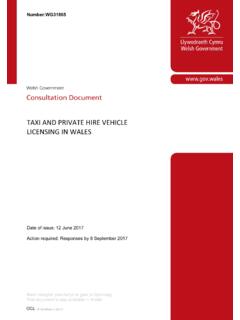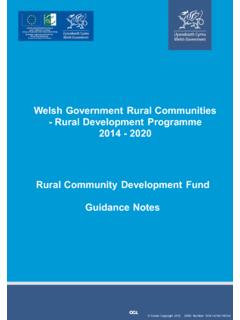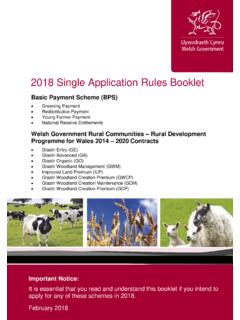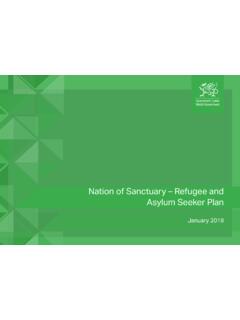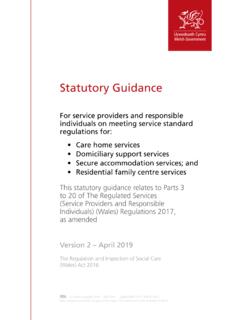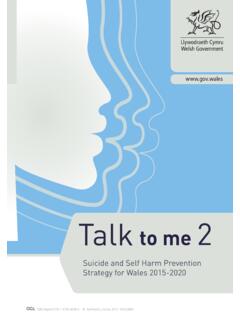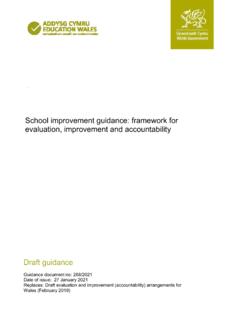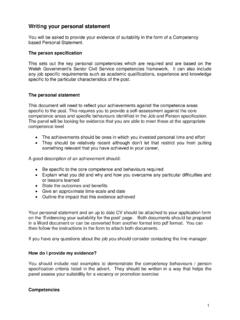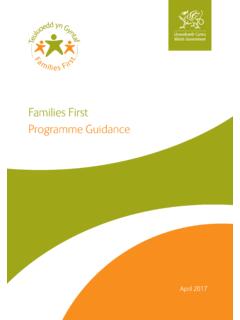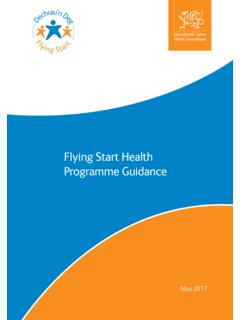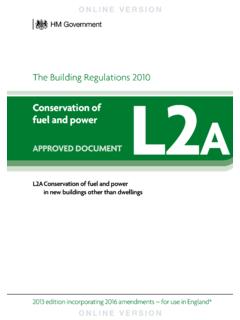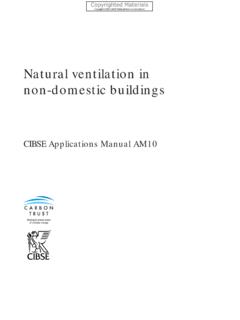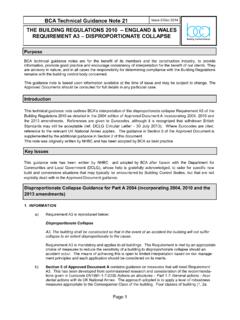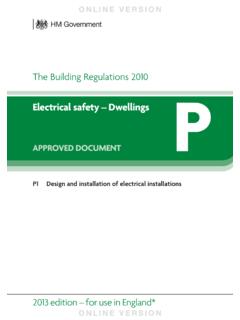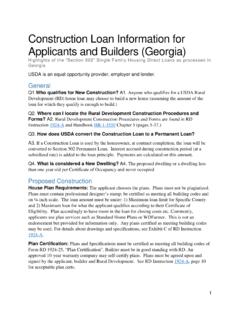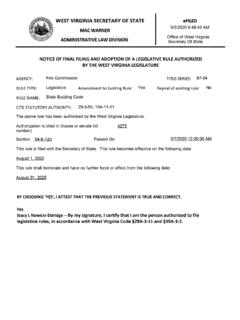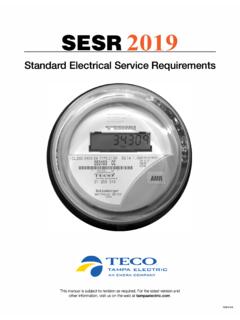Transcription of Approved Document - Welsh Government
1 M. The Building Regulations 2010. M. Approved Document M1 Access and use M2 Access to extensions to buildings other than dwellings M3 Sanitary conveniences in extensions to buildings other than dwellings M4 Sanitary conveniences in dwellings Access to and use of buildings 2004 edition incorporating For use in Wales* 2010 amendments Main Changes in the 2004 Edition This edition of the Approved Document M, Access to and use of buildings replaces the 1999. edition entitled Access and facilities for disabled people. The main changes are: a. Part M now applies generally to material alterations of and extensions to existing non-domestic builidngs. It applies to material changes of use to some non-domestic uses.
2 There is no exception for historic buildings, but this new edition of AD M contains guidance on such buildings. The guidance on dwellings in Sections 6 to 10 remains unchanged from the 1999. edition of AD M, with the exception that some diagram numbers and their text references have been changed to permit consistency with the amended Sections 1 to 5. Some publication references, particularly those concerning lifts and sports facilities, have been replaced to reflect the most recent guidance available. b. The guidance draws on the recommendations of British Standard BS 8300:2001 Design of buildings and their approaches to meet the needs of disabled people Code of Practice'. There are some instances where the guidance in this Approved Document differs from the recommendations in the edition of BS 8300 current at the date of publication of the AD.
3 It is the intention of the British Standards Institution to review such anomalies as may exist and where practicable to take them into account in future editions of the standard. c. The requirements in the new Part M no longer refer to disabled people'. The aim of the new Part M and AD M is to foster a more inclusive approach to design to accommodate the needs of all people. A new section in the AD (Section 4) on Facilities in buildings other than dwellings'. has been introduced to cover audience and spectator facilities, refreshment facilities, sleeping accommodation and switches, outlets and controls. The guidance on changing facilities has been relocated to Section 5 Sanitary accommodation in buildings other than dwellings'.
4 This new edition of AD M includes guidance in Section 0 General Guidance' on educational establishments and clarifies the treatment of purpose-built student accommodation. d. The explanation of the relationship between Part M and the Disability Discrimination Act 1995. has been amended in Use of Guidance' to reflect Regulations made or revoked since the 1999. edition of AD M was published. e. The concept of the Access Statement has been introduced for the first time. It is recommended that an Access Statement is provided to identify the philosophy and approach to inclusive design adopted, particularly when the approach taken to satisfying the Requirements differs from that represented by the guidance in the Approved Document .
5 Approved Document M, Access to and use of buildings. Main changes made by the 2010 amendments This 2004 edition incorporating the 2010 amendments reflects the changes made as a result of the Building Regulations 2010 and Building ( Approved Inspectors etc) Regulations 2010. The changes mainly reflect regulation number changes as a result of re-ordering. There have been no amendments to the substantive requirements in Schedule 1 ( Parts A to P) of the Building Regulations. Please note the simplification of the definition of room for residential purposes' in regulation 2. of the Building Regulations 2010. Please also note that L1(c) has now become regulation 40. Crown copyright Digital ISBN 978 1-4734-7636-3 WG29835.
6 Contents > Use of Guidance > Section 0 | 1 | 2 | 3 | 4 | 5 | 6 | 7 | 8 | 9 | 10 > Appendix Contents Use of guidance 8. The Approved documents 8. Limitation on requirements 8. Materials and workmanship 8. The Workplace (Health, Safety And Welfare) Regulations 1992 9. Disability Discrimination Act 1995 and the Disability Discrimination (employment). Regulations 1996 9. The Requirements 11. Section 0: General guidance 16. Performance 16. Where the requirements apply 16. Application of Part M 16. Extensions and material alterations: dwellings 16. Extensions of non-domestic buildings 17. Material alterations of non-domestic buildings 18. Material changes of use 18. Car parking and setting down 19.
7 What requirements apply 19. i. Buildings other than dwellings 19. ii. Dwellings 19. Educational establishments 19. Historic buildings 20. Access statements 20. Definitions 22. Section 1: Access to buildings other than dwellings 24. Objectives 24. Level approach from the boundary of the site and car parking 24. On-site car parking and setting down 25. Ramped access 28. Stepped access 29. Handrails to external stepped and ramped access 32. Hazards on access routes 33. Welsh Government . Approved Document M: Access to and use of buildings 3. Contents > Use of Guidance > Section 0 | 1 | 2 | 3 | 4 | 5 | 6 | 7 | 8 | 9 | 10 > Appendix Section 2: Access into buildings other than dwellings 35.
8 Objectives 35. Accessible entrances 35. Doors to accessible entrances 36. Manually operated non-powered entrance doors 37. Powered entrance doors 38. Glass entrance doors and glazed screens 39. Entrance lobbies 39. Section 3: Horizontal and vertical circulation in buildings other than dwellings 42. Objective 42. Entrance hall and reception area 42. Internal doors 43. Corridors and passageways 44. Internal lobbies 45. Vertical circulation within the building 46. Provision of lifting devices 46. General requirements for lifting devices 47. Passenger lifts 47. Lifting platforms 49. Wheelchair platform stairlifts 50. Internal stairs 51. Internal ramps 51. Handrails to internal steps, stairs and ramps 52.
9 Section 4: Facilities in buildings other than dwellings 53. Objectives 53. Audience and spectator facilities 53. Refreshment facilities 55. Sleeping accommodation 57. Switches, outlets and controls 59. Aids to communication 61. Section 5: Sanitary accomodation in buildings other than dwellings 63. Objectives 63. Sanitary accommodation generally 63. Provision of toilet accommodation 64. Wheelchair-accessible unisex toilets 65. Toilets in separate-sex washrooms 68. Wheelchair-accessible changing and shower facilities 70. Wheelchair-accessible bathrooms 73. Welsh Government . Approved Document M: Access to and use of buildings 4. Contents > Use of Guidance > Section 0 | 1 | 2 | 3 | 4 | 5 | 6 | 7 | 8 | 9 | 10 > Appendix Section 6: Means of access to and into the dwelling 76.
10 Objective 76. Approach to the dwelling 76. Level approach 77. Ramped approach 77. Stepped approach 77. Approach using a driveway 77. Access into the dwelling 78. Entrance doors 79. Section 7: Circulation within the entrance storey of the dwelling 80. Objective 80. Corridors, passageways and internal doors within the entrance storey 80. Vertical circulation within the entrance storey 81. Section 8: Accessible switches and socket outlets in the dwelling 82. Objective 82. Section 9: Passenger lifts and common stairs in blocks of flats 83. Objectives 83. Common stairs 83. Lifts 85. Section 10: WC provision in the entrance storey of the dwelling 86. Objectives 86. Appendix: Index 88. Appendix: Standards referred to 94.
